- Top Trumpet Embouchure Techniques: Options for Beginners Through Professionals - October 12, 2022
- Is the Trumpet Hard to Learn? - September 30, 2022
- Best Leblanc Clarinet Models Guide: From Soprano to Contrabass - September 5, 2022
Whether you’ve seen Lizzo play it or heard it on a recording by Jethro Tull, the flute is everywhere. If you want to be the next Lizzo or Ian Anderson, you should learn how to play the flute. The flute is one of the oldest instruments in the world, and it’s gone through many changes over the centuries. Now, we have a flute that’s easy to play, and you can use it to play everything from Bach to jazz to beatboxing.
If you want to join the flute world, first take some time to learn about the instrument and then find one that works for you and helps you get started off on the right note.
What Is The Flute?
The flute is a woodwind instrument that doesn’t use a reed to produce a sound. When most of us think of a flute, we think of a western concert flute, which has a special hole on the side of the tube. As a flute player, you blow into that hole to produce a sound.
A concert flute also has a line of holes going down the body of the instrument with keys over them. By opening or closing certain keys, you can produce different notes on the flute. The flute is one of the highest-pitched instruments in the orchestra.
Flutes have been around for thousands of years, but the flute as we know it today didn’t exist until the 19th century. Until then, flutes were wood instead of metal, and they didn’t have many or any keys.
The current flute has three parts, including a headjoint, body, and footjoint. You’ll blow into a hole in the headjoint, the body has the majority of the keys, and the footjoint has a few more keys.
Beginner Flute Specs
When shopping for your first flute, you may find different models, though most beginner flutes share the same specs. These specs make it easy to start playing the flute.
- Closed holes
- C footjoint
- Silver plating
Take a look at this video to learn about different flute specs!
Best Flutes For Beginners
If you search for flutes, you can find hundreds, if not thousands, of models available. I’ve played at least a dozen flutes during my time as a flute player, and each flute is a bit different.
That’s why it’s crucial to find the perfect flute for you. The best flute for me or another player might not work well for you. Luckily, you don’t need to try a bunch of flutes as a beginner. Many of these models are meant for new players, so they’re easy to get a sound on, and some even have a more ergonomic design than other flutes.
Yamaha YFL-222

Yamaha is one of the best flute brands for new players. Their instruments are durable and can handle a few nicks and bumps without needing extensive repairs.
The YFL-222 has the standard specs of a beginner flute, including closed holes, a C footjoint, and silver plating. Closed holes are great because they allow you to learn how to play the flute without having your hands in the “right” position.
A C footjoint’s lowest note is C, so it’s shorter and lighter than most intermediate and professional flutes. As you learn how to play the flute, you won’t have to worry as much about dropping a shorter, lighter instrument.
Silver plating is also more affordable and durable than solid silver. You may not want to invest a ton of money into your first flute, but the Yamaha YFL-222 is a great choice.
The YFL-222's closed-hole function keys let your beginner flutist enjoy learning to play the flute while facilitating proper hand position.
Pearl 505

The Pearl 505 flute is another fantastic model for learning the flute. It has all of the same specs as the Yamaha flute, except it has open hole keys instead of closed.
Open holes are excellent for learning and reinforcing a good hand position. When you play a flute with closed holes, you can put your fingers anywhere, but open holes require you to cover the holes as you close the keys. Another difference is that the 505 has what’s called a split-E mechanism. The third octave E on the flute can be difficult to play with a clear sound, and the split-E mechanism makes it easier.
This flute also comes with a soft case cover that you can use to store cleaning supplies. That way, you can keep moisture from accumulating inside of your flute.
The new Quantz 505 flute joins the famous Pearl Quantz series, with this completely new Silver plated instrument. Now, every Pearl flute, from this novice model to our Maesta line, has French pointed arms - an industry first. The trademark Pearl sound and intonation standards are maintained.
Pearl 525
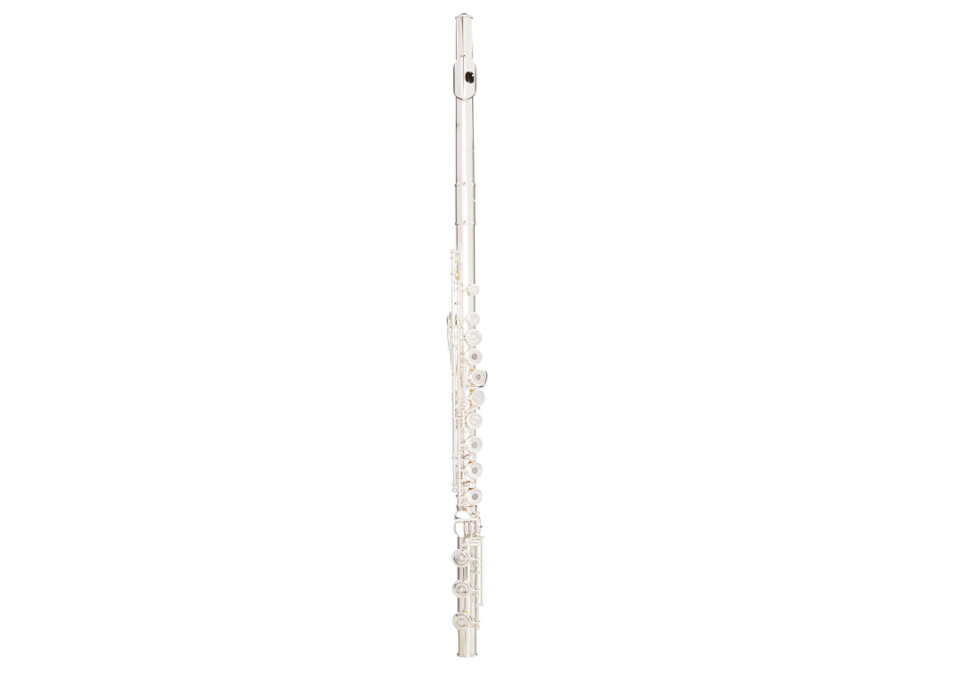
Pearl has another great beginner flute with the Pearl 525. It has many of the same features as the 505, but there are two differences. For one, it has a B footjoint instead of a C footjoint. This means the flute can play as low as the B just below middle C.
It also features a solid silver lip plate and riser, which is where you blow to make the sound. Having that be solid silver helps the flute sound a bit warmer, and you may not have the need to upgrade as quickly after you start playing the flute.
I know people who have played beginner flutes from Pearl, and they do well on them. And I play one of Pearl’s professional models, and the quality extends throughout their line of instruments.
The Quantz series embodies ingenuity, innovation, and diversity, and is totally unique in the flute making industry. Aspiring Pied Pipers have never been so lucky.
Gemeinhardt 2SP
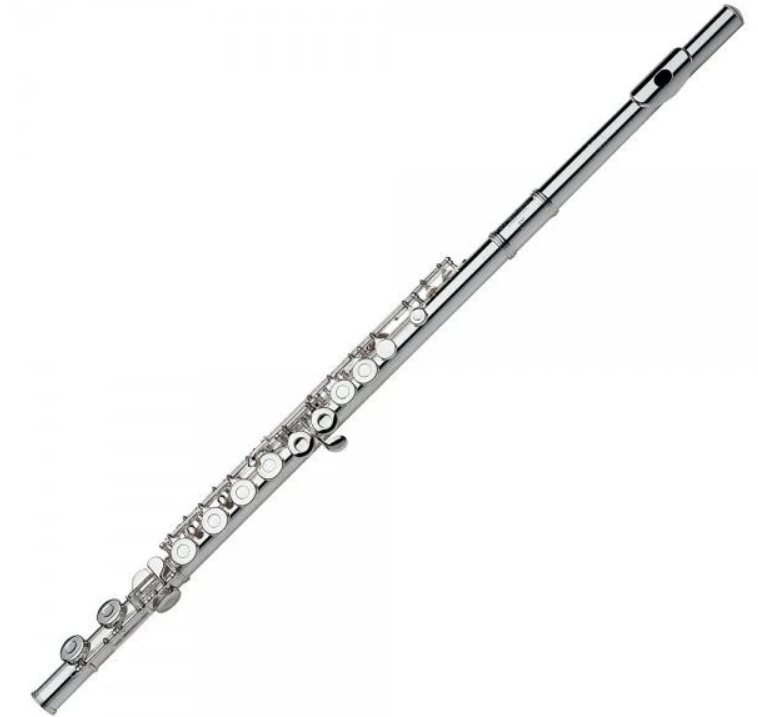
The Gemeinhardt 2SP has many of the same specs as the Yamaha YFL-222, including closed holes and a C footjoint. It’s a more affordable flute, so it’s perfect for beginners on a budget. This model is one of the most popular beginner flutes on the market. You can use it to play in a band, private lessons, or on your own.
Gemeinhardt focuses on flutes, and professionals test each instrument to make sure the quality is there. That way, you don’t have to worry about getting an instrument that you can’t play. If you don’t like the open holes on the Pearl flutes but don’t want to spend as much on the Yamaha, consider the Gemeinhardt. It may be the perfect first flute for you.
The 2SP has been a standard and reliable instrument choice for decades and remains the most popular instrument selected by dealers and educators for beginning flutists. With an unprecedented level of quality control including two tiers of professional Magnehelic bench testing, the 2SP provides a solid foundation for student musicians to build on.
Trevor James 10X

One of the first flutes I played was a Trevor James 10X, and I can’t recommend it enough. The British flute brand makes excellent flutes for students, and this flute has the same specs as the Yamaha and Gemeinhardt. It comes in two versions, the first of which is the 10XC. This is the version that I played and still own, and it’s an excellent option for older kids and adults.
However, Trevor James also makes the 10XC2, which comes with a straight and curved head joint. A curved headjoint looks like a J, and it brings the flute closer to the player. That way, younger students or people with shorter arms can reach the keys more easily. As your young student outgrows the curved head joint, they can switch to the straight one without having to get a new flute.
Beginner flute is designed for the very young with the ability to grow with the child.
Jupiter JFL700

Another beginner flute to consider is the Jupiter JFL700. It has the same design and specs as the Yamaha, Gemeinhardt, and the Trevor James 10XC. The flute comes in a hard case to protect it from bumps as you walk around with the instrument. When you take it out of the case, you can put it together in the same way as any other flute.
Like the Trevor James beginner flute, Jupiter has a special design to help smaller and younger players. The JFL700WD uses a wave line design to bring the flute closer to the player. It also has a D food joint, meaning that it can’t play quite as low as other flutes. However, that’s great for beginners who want a lightweight flute.
The Jupiter Model JFL700 closed-hole flute is an excellent choice for the beginning flute player. This series utilizes a high nickel content in its entire flute tubing to produce an excellent sound quality.
What You Should Look For When Shopping For Your First Flute
Having the right flute is a crucial step in learning how to play the flute. You can find tons of cheap models available online, but they don’t all offer the quality you need. As a beginner, you should have the best instrument possible to minimize your struggles as you learn. I briefly played a cheap model from a brand that wasn’t reputable, and it wasn’t a great experience.
Luckily, you can avoid that problem by choosing a good flute. Whether you go with one of the best flutes for beginners or another option, you should consider a few factors as you shop around.
Lightweight
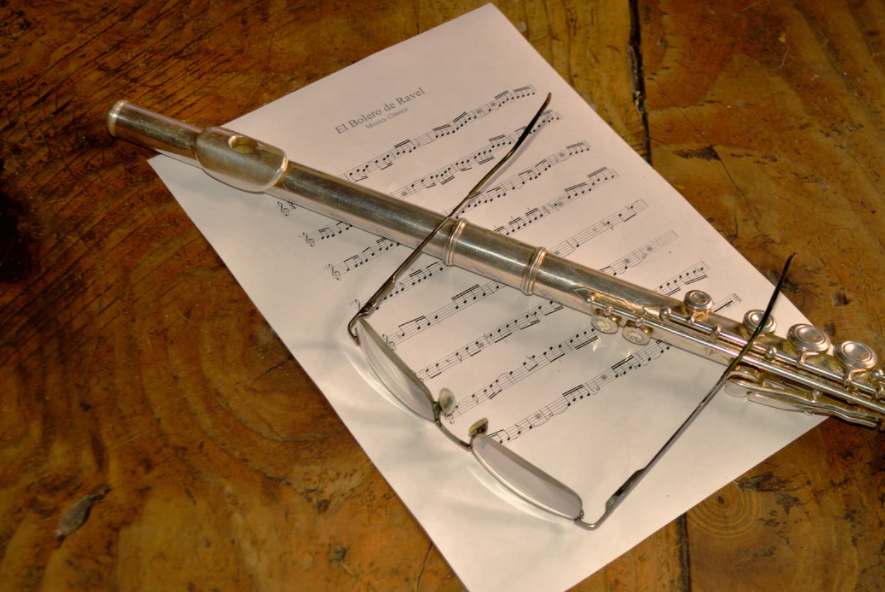
Holding the flute can put your body and arms in an awkward position, and it’s hard to get used to. If you have to learn that position with a heavier flute, you may put a lot of stress on your arms. A lightweight flute gives you the chance to learn the correct position so that you can balance the flute and play it. Now, you may upgrade to something heavier, such as with more keys.
But you should be comfortable with the flute before you add more weight to it. That way, you can focus on learning the notes and getting a good sound.
Durable
You may think it’s weird to consider a flute durable, but it’s important. When I started learning the flute, I wasn’t as comfortable with how to hold it and protect it. I’m sure my beginner flute took quite a beating, even with small nicks or bumps. As you start learning to play the flute, you should use a flute that can withstand some minor issues.
Silver plating is great for this because the main metal is nickel, which is more durable than solid silver. More precious metals may offer a different sound, but they’re more delicate.
Maintenance
As you play the flute, certain parts of the mechanism can go out of alignment and make the flute harder to play. Fortunately, you can take your flute to a music shop for a repair service. However, many repair technicians won’t work on the cheaper models. That means you may need to buy a new flute after a few months of playing, and the costs can add up.
On the other hand, taking a flute from a reputable brand for maintenance is much more affordable. If you want to be able to play the flute for years, you need to make sure someone can fix it.
Design
Another consideration if you’re smaller or if your child will learn the flute is the instrument’s design. Many flutes use a straight tube, and that works for a lot of players. However, younger students and students with shorter arms may struggle. Luckily, the Trevor James 10XC2 and the Jupiter JFL700WD solve that problem in different ways.
The Trevor James uses a curved headjoint, while the Jupiter creates a wave to help bring the headjoint closer to the body. The Jupiter makes the flute shorter overall, which can lower the weight as you learn.
You may also want to look at closed-hole flutes so that you don’t have to use the right position from the start. If you go for one of the open-hole flutes, you can use special plugs to close the holes for you.
How To Play The Flute
Now that you have a good beginner instrument, it’s time to learn how to play the flute. It won’t be easy, and it can take time to refine your skills and make a sound consistently.
However, it’s well worth the effort. Once you get the hang of it, there are tons of pieces for the flute that you can play as you improve your skills.
Consider the following steps as you start to learn to play the flute.
Start With The Headjoint
The headjoint is the part of the flute you use to create a sound. You should start by playing the headjoint by itself so that you can make a sound more easily.
Take the headjoint out of your flute case by the end and not the embouchure hole where you blow. Form your lips as if you’re going to kiss or blow over the edge of a soda bottle and place the headjoint against your lower lip.
The open end of the headjoint should be on the right, which is how you’ll hold the flute once you assemble it. Take a big breath and blow over the edge of the flute.
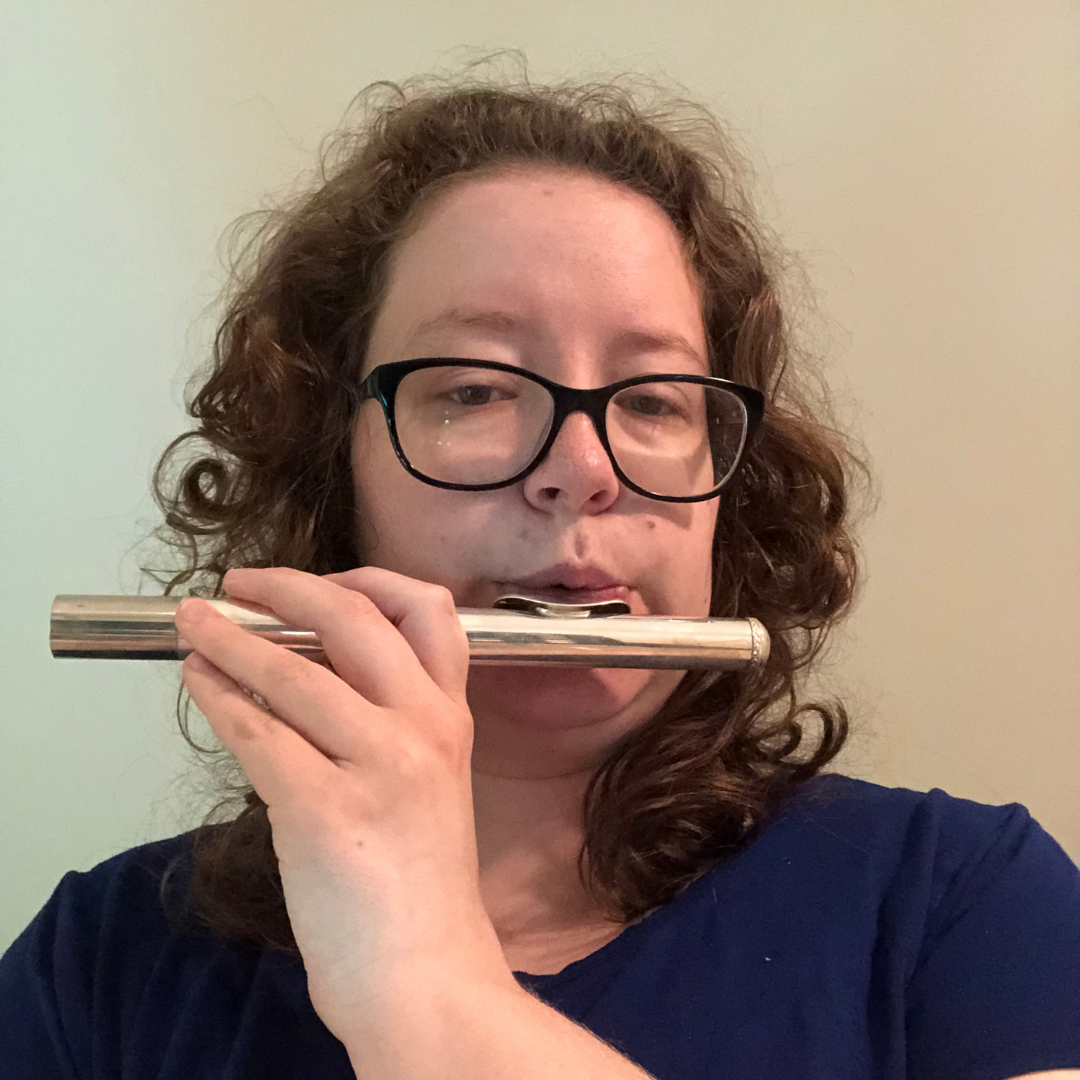
Practice blowing into the headjoint with the end of it open and closed. Closing the end with the palm of your right hand can give you a different pitch to make things more interesting.
Assemble The Flute
Once you get a sound using the headjoint, you can add the body and the footjoint or just the body. Adding just the body means you won’t have to deal with as much weight.
When you add the body, make sure you line the embouchure hole (where you blow) with the keys on the body. If you add the footjoint, you should line up the keys so that they’re slightly behind the keys on the body to help your pinky reach them.
Place your hands on the smooth parts of the flute to avoid bending the keys, which can make the flute hard to play.

Your First Notes
Now, you’re ready to start playing a few notes on the flute. The first note that many flute players learn is B, which is in the middle of the treble clef staff.
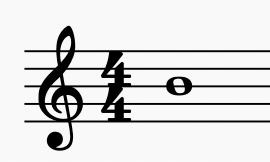
To play B, you’ll need to use the first finger of your left hand to close the small key and the longer thumb key on the back.
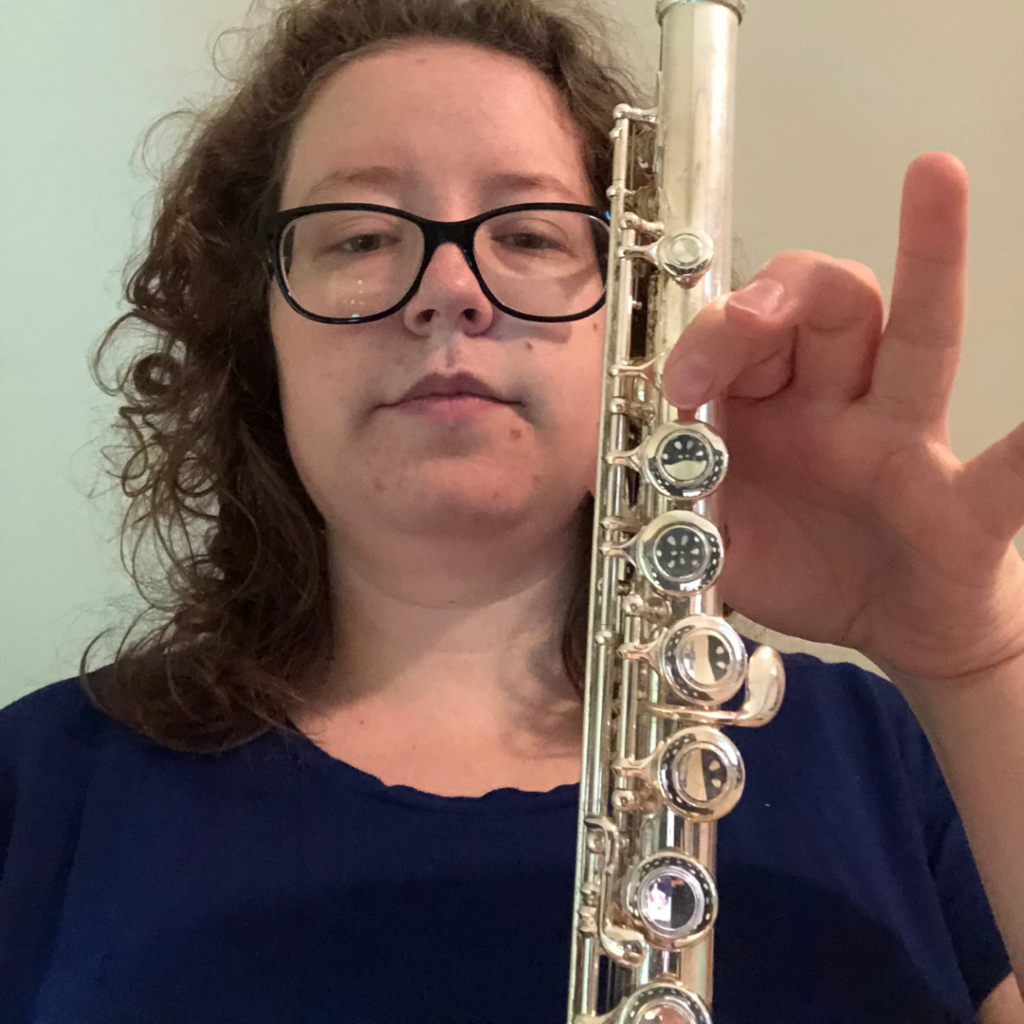
The next note, A, is in the space just below the B, and you’ll skip a key and then add a key with your second finger. To play G, you will add your third finger to the key right next to the A key.
When you first start, you can place your right hand on the “barrel” or the smooth part of the flute body. That can help you stabilize the flute before you need to use your right hand to play notes.
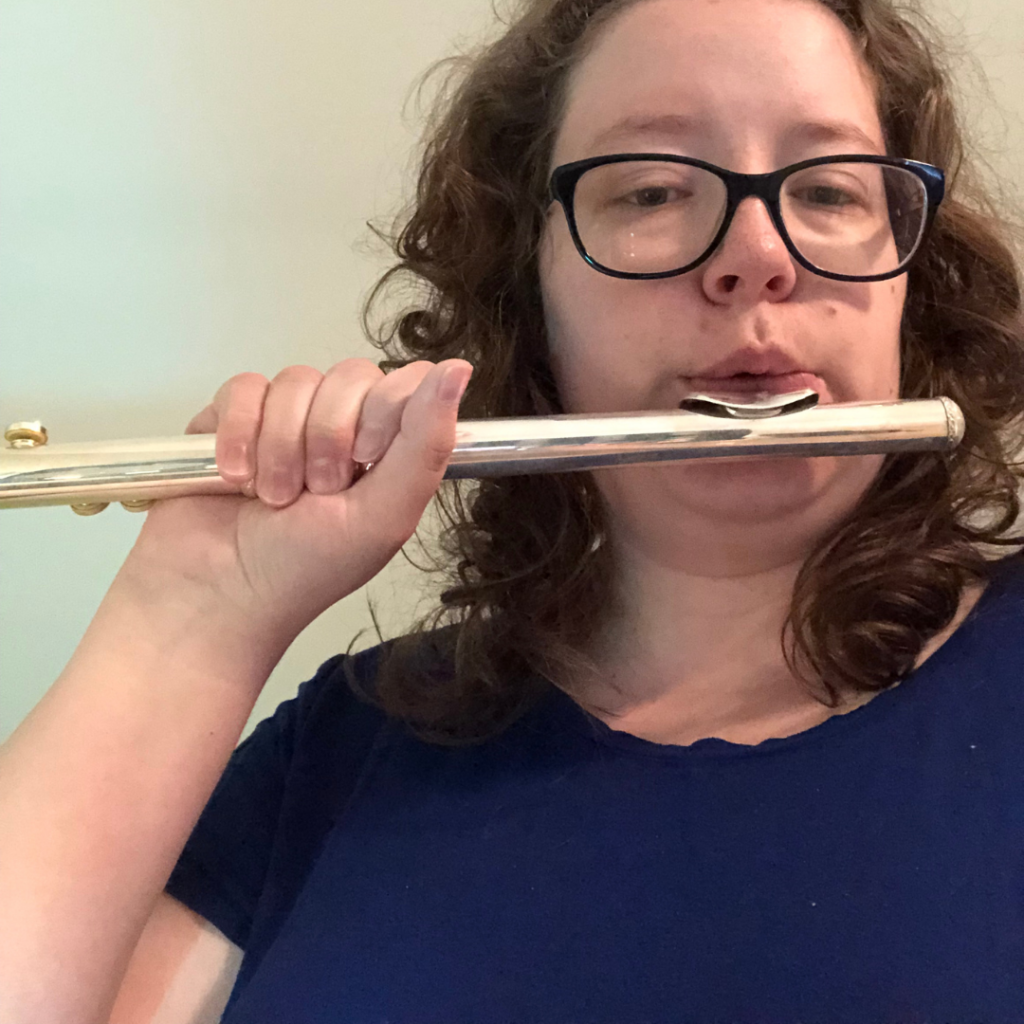
Your First Song
Three notes may not seem like a lot, but you can play tons of songs with only those notes. Hot Cross Buns is one of the easiest songs to learn. It uses the following notes:
B A G
B A G
G G G G
A A A A
B A G
Mary Had a Little Lamb is another great song you can play with only B, A, and G. You can use these songs to get the hang of playing different notes on the flute before you add the right hand.
Get A Good Flute Book
The next step in how to play the flute is to get a flute book with more lessons and information. You can use the book to learn more notes and how to place your fingers for each one.
One great book to use is the Rubank Elementary Method for Flute. Method books for band classes are also great, even if you aren’t in a band learning to play.
These books come with a chart of the fingerings you will use as you progress as a flute player. And they’re great to use with or without a private flute teacher.
In this video, I talk about some of the best beginner flute books. That way, you can learn even more about how to play the flute.
Consider Classes and Lessons
While not necessary, you can take classes or lessons to help you learn the flute. Working with a teacher can help you learn how to properly hold the flute and how to get a good sound.
If you take a group class, you can learn with other students at the same level. Then, you can play music together, which can help you enjoy learning.
Private lessons allow you to get personal feedback on your playing, and you can learn at your own pace. That way, you can enjoy the flute rather than have it stress you out.
However, classes and lessons can be expensive. There are tons of free and cheap resources available online to help you learn how to play the flute.
FAQs
Answer: The flute isn’t as difficult as some instruments, but it’s not the easiest to learn. If you want to learn, that can make it easier to pick up the flute and play each day, so it may feel easier to learn.
However, it will take consistent practice to build your skills. One thing that does make it easier than the piano, for example, is that you only have to worry about one note at a time. Piano players may have multiple notes to play.
Answer: If you’ve ever blown across the top of a bottle, you can make a sound on the flute. You’ll need to put your lips together to form your embouchure, which is how you’ll play.
Many players can blow through the middle of their lips. However, I’m one of many other players who play off to the side because of my cupid’s bow. Either position works as long as you can get a good sound.
Answer: You can teach yourself how to play the flute. When I started learning, I didn’t take my flute to a private teacher, but I did look for lessons and resources online to help.
If you want to learn flute without a teacher, you’ll need to motivate yourself to practice each day or week. That way, you can keep learning new notes and songs on your instrument.
Answer: It can take weeks, months, or years, depending on your goals. If your main goal is to make a sound, you may reach that goal in a few days or weeks.
However, being able to play a Mozart concerto or a Bach sonata, or another major work can take years. The most important thing is that you’re consistent and that you don’t let not reaching your goals keep you from practicing.
Answer: The cost of a flute varies considerably depending on the specs, materials, and amount of handmade vs. machine-made. You can find cheap flutes for less than $100, and reliable models start at around $500 new.
On the other end of the spectrum, you can find flutes as expensive as $84,000. These flutes use gold and platinum, which are expensive, and they’re entirely handmade. Luckily, you can find more affordable options if you buy a used flute.
Answer: The best way to start playing flute on a budget is to rent or buy a used flute from a reputable brand and music store. You can buy an affordable music book, or you can use free articles and videos online.
While private or group lessons are useful, they aren’t necessary to learn. As long as you’re interested and can make time, you can learn how to play the flute.
Question: What types of flutes can you play once you have mastered the standard one?
Answer: There are about 13 different types of flutes. The most common are the:
- Concert Flute
- Piccolo Flute
- Alto Flute
- Bass Flute
- Eb Soprano Flute
- Recorder or plastic flute
Final Note On How To Play The Flute
Learning how to play the flute is rewarding, and it’s a great option for a hobby or career. When you first learn, it can take a while to get used to holding the flute and producing a sound. However, once you learn the basics, you can improve and learn even more. Then, you can play some of your favorite pieces on the flute on your own or as part of a group.






